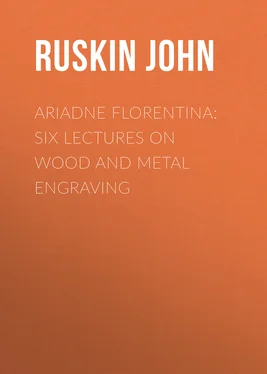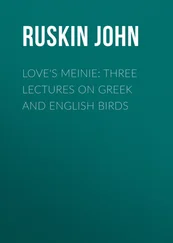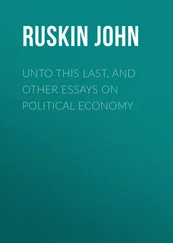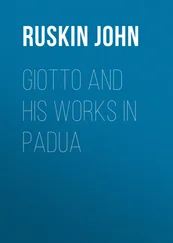John Ruskin - Ariadne Florentina - Six Lectures on Wood and Metal Engraving
Здесь есть возможность читать онлайн «John Ruskin - Ariadne Florentina - Six Lectures on Wood and Metal Engraving» — ознакомительный отрывок электронной книги совершенно бесплатно, а после прочтения отрывка купить полную версию. В некоторых случаях можно слушать аудио, скачать через торрент в формате fb2 и присутствует краткое содержание. Жанр: foreign_home, literature_19, visual_arts, foreign_antique, на английском языке. Описание произведения, (предисловие) а так же отзывы посетителей доступны на портале библиотеки ЛибКат.
- Название:Ariadne Florentina: Six Lectures on Wood and Metal Engraving
- Автор:
- Жанр:
- Год:неизвестен
- ISBN:нет данных
- Рейтинг книги:4 / 5. Голосов: 1
-
Избранное:Добавить в избранное
- Отзывы:
-
Ваша оценка:
- 80
- 1
- 2
- 3
- 4
- 5
Ariadne Florentina: Six Lectures on Wood and Metal Engraving: краткое содержание, описание и аннотация
Предлагаем к чтению аннотацию, описание, краткое содержание или предисловие (зависит от того, что написал сам автор книги «Ariadne Florentina: Six Lectures on Wood and Metal Engraving»). Если вы не нашли необходимую информацию о книге — напишите в комментариях, мы постараемся отыскать её.
Ariadne Florentina: Six Lectures on Wood and Metal Engraving — читать онлайн ознакомительный отрывок
Ниже представлен текст книги, разбитый по страницам. Система сохранения места последней прочитанной страницы, позволяет с удобством читать онлайн бесплатно книгу «Ariadne Florentina: Six Lectures on Wood and Metal Engraving», без необходимости каждый раз заново искать на чём Вы остановились. Поставьте закладку, и сможете в любой момент перейти на страницу, на которой закончили чтение.
Интервал:
Закладка:
45. To-day I will endeavor to explain how they attained such rank. Then, in the next two lectures, the technics of both,—their way of speaking; and in the last two, what they had got to say.
First, then, we ask how they attained this rank;—who taught them what they were finally best to teach? How far must every people—how far did this Florentine people—teach its masters, before they could teach it ?
Even in these days, when every man is, by hypothesis, as good as another, does not the question sound strange to you? You recognize in the past, as you think, clearly, that national advance takes place always under the guidance of masters, or groups of masters, possessed of what appears to be some new personal sensibility or gift of invention; and we are apt to be reverent to these alone, as if the nation itself had been unprogressive, and suddenly awakened, or converted, by the genius of one man.
No idea can be more superficial. Every nation must teach its tutors, and prepare itself to receive them; but the fact on which our impression is founded—the rising, apparently by chance, of men whose singular gifts suddenly melt the multitude, already at the point of fusion; or suddenly form, and in form, the multitude which has gained coherence enough to be capable of formation,—enables us to measure and map the gain of national intellectual territory, by tracing first the lifting of the mountain chains of its genius.
46. I have told you that we have nothing to do at present with the great transition from ancient to modern habits of thought which took place at the beginning of the sixteenth century. I only want to go as far as that point;—where we shall find the old superstitious art represented finally by Perugino, and the modern scientific and anatomical art represented primarily by Michael Angelo. And the epithet bestowed on Perugino by Michael Angelo, 'goffo nell' arte,' dunce, or blockhead, in art,—being, as far as my knowledge of history extends, the most cruel, the most false, and the most foolish insult ever offered by one great man to another,—does you at least good service, in showing how trenchant the separation is between the two orders of artists, 8 8 He is said by Vasari to have called Francia the like. Francia is a child compared to Perugino; but a finished working-goldsmith and ornamental painter nevertheless; and one of the very last men to be called 'goffo,' except by unparalleled insolence.
—how exclusively we may follow out the history of all the 'goffi nell' arte,' and write our Florentine Dunciad, and Laus Stultitiæ, in peace; and never trench upon the thoughts or ways of these proud ones, who showed their fathers' nakedness, and snatched their masters' fame.
47. The Florentine dunces in art are a multitude; but I only want you to know something about twenty of them.
Twenty!—you think that a grievous number? It may, perhaps, appease you a little to be told that when you really have learned a very little, accurately, about these twenty dunces, there are only five more men among the artists of Christendom whose works I shall ask you to examine while you are under my care. That makes twenty-five altogether,—an exorbitant demand on your attention, you still think? And yet, but a little while ago, you were all agog to get me to go and look at Mrs. A's sketches, and tell you what was to be thought about them ; and I've had the greatest difficulty to keep Mrs. B's photographs from being shown side by side with the Raphael drawings in the University galleries. And you will waste any quantity of time in looking at Mrs. A's sketches or Mrs. B's photographs; and yet you look grave, because, out of nineteen centuries of European art-labor and thought, I ask you to learn something seriously about the works of five-and-twenty men!
48. It is hard upon you, doubtless, considering the quantity of time you must nowadays spend in trying which can hit balls farthest. So I will put the task into the simplest form I can.
Here are the names of the twenty-five men, 9 9 The diagram used at the lecture is engraved on page 30; the reader had better draw it larger for himself, as it had to be made inconveniently small for this size of leaf.
and opposite each, a line indicating the length of his life, and the position of it in his century. The diagram still, however, needs a few words of explanation. Very chiefly, for those who know anything of my writings, there is needed explanation of its not including the names of Titian, Reynolds, Velasquez, Turner, and other such men, always reverently put before you at other times.
They are absent, because I have no fear of your not looking at these. All your lives through, if you care about art, you will be looking at them. But while you are here at Oxford, I want to make you learn what you should know of these earlier, many of them weaker, men, who yet, for the very reason of their greater simplicity of power, are better guides for you, and of whom some will remain guides to all generations. And, as regards the subject of our present course, I have a still more weighty reason;—Vandyke, Gainsborough, Titian, Reynolds, Velasquez, and the rest, are essentially portrait painters. They give you the likeness of a man: they have nothing to say either about his future life, or his gods. 'That is the look of him,' they say: 'here, on earth, we know no more.'
49. But these, whose names I have engraved, have something to say—generally much,—either about the future life of man, or about his gods. They are therefore, literally, seers or prophets. False prophets, it may be, or foolish ones; of that you must judge; but you must read before you can judge; and read (or hear) them consistently; for you don't know them till you have heard them out. But with Sir Joshua, or Titian, one portrait is as another: it is here a pretty lady, there a great lord; but speechless, all;—whereas, with these twenty-five men, each picture or statue is not merely another person of a pleasant society, but another chapter of a Sibylline book.
50. For this reason, then, I do not want Sir Joshua or Velasquez in my defined group; and for my present purpose, I can spare from it even four others:—namely, three who have too special gifts, and must each be separately studied—Correggio, Carpaccio, Tintoret;—and one who has no special gift, but a balanced group of many—Cima. This leaves twenty-one for classification, of whom I will ask you to lay hold thus. You must continually have felt the difficulty caused by the names of centuries not tallying with their years;—the year 1201 being the first of the thirteenth century, and so on. I am always plagued by it myself, much as I have to think and write with reference to chronology; and I mean for the future, in our art chronology, to use as far as possible a different form of notation.
51. In my diagram the vertical lines are the divisions of tens of years; the thick black lines divide the centuries. The horizontal lines, then, at a glance, tell you the length and date of each artist's life. In one or two instances I cannot find the date of birth; in one or two more, of death; and the line indicates then only the ascertained 10 10 'Ascertained,' scarcely any date ever is, quite satisfactorily. The diagram only represents what is practically and broadly true. I may have to modify it greatly in detail.
period during which the artist worked.
And, thus represented, you see nearly all their lives run through the year of a new century; so that if the lines representing them were needles, and the black bars of the years 1300, 1400, 1500 were magnets, I could take up nearly all the needles by lifting the bars.
52. I will actually do this, then, in three other simple diagrams. I place a rod for the year 1300 over the lines of life, and I take up all it touches. I have to drop Niccola Pisano, but I catch five. Now, with my rod of 1400, I have dropped Orcagna indeed, but I again catch five. Now, with my rod of 1500, I indeed drop Filippo Lippi and Verrocchio, but I catch seven. And here I have three pennons, with the staves of the years 1300, 1400, and 1500 running through them,—holding the names of nearly all the men I want you to study in easily remembered groups of five, five, and seven. And these three groups I shall hereafter call the 1300 group, 1400 group, and 1500 group.
Читать дальшеИнтервал:
Закладка:
Похожие книги на «Ariadne Florentina: Six Lectures on Wood and Metal Engraving»
Представляем Вашему вниманию похожие книги на «Ariadne Florentina: Six Lectures on Wood and Metal Engraving» списком для выбора. Мы отобрали схожую по названию и смыслу литературу в надежде предоставить читателям больше вариантов отыскать новые, интересные, ещё непрочитанные произведения.
Обсуждение, отзывы о книге «Ariadne Florentina: Six Lectures on Wood and Metal Engraving» и просто собственные мнения читателей. Оставьте ваши комментарии, напишите, что Вы думаете о произведении, его смысле или главных героях. Укажите что конкретно понравилось, а что нет, и почему Вы так считаете.












![John Bruce - The Lettsomian Lectures on Diseases and Disorders of the Heart and Arteries in Middle and Advanced Life [1900-1901]](/books/749387/john-bruce-the-lettsomian-lectures-on-diseases-and-disorders-of-the-heart-and-arteries-in-middle-and-advanced-life-1900-1901-thumb.webp)